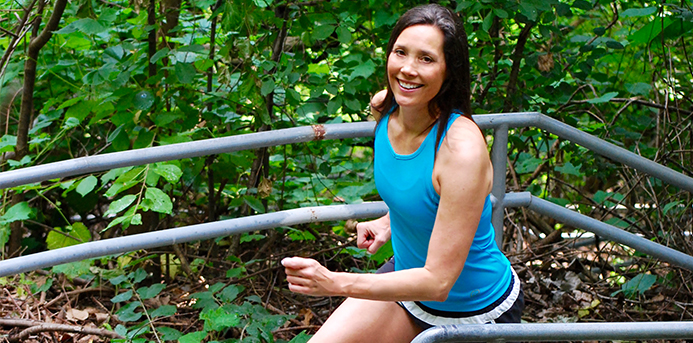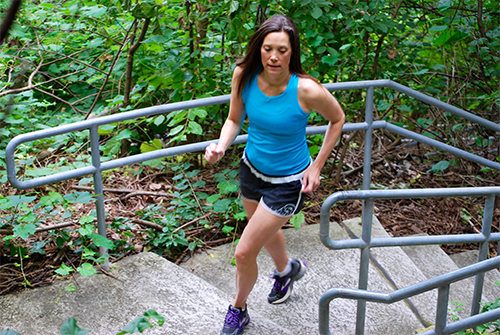Need a workout that’s easy to fit into even the busiest of schedules, can be done anywhere, requires little equipment, and is easier on your body than running? Chances are you’re already doing some walking every day, but with a little extra effort, you can turn your daily strides into a great workout.
According the Centers for Disease Control and Prevention (CDC), “More than 145 million adults now include walking as part of a physically active lifestyle.”
The health benefits of regular walking, notes the CDC, include:
- Weight control
- Reduced risk of cardiovascular disease
- Reduced risk for type 2 diabetes and metabolic syndrome
- Reduced risk for some cancers
- Stronger bones and muscles
- Improved mental health and mood
- Improved ability to do daily activities and prevent falls as you age
- Increased chance of living longer
Ready to get moving? Here are 11 ways to get the most out of your walks:
1. Move your walk to the woods or waterfront.
Studies have shown that walking in nature improves cognitive ability and reduces anxiety and other mental health disorders. Recruit a friend or bring your four-legged one along and hit the trail in a nearby forest preserve. Your mind will be relieved from intense thought as you negotiate fallen trees, balance on a log bridge, climb a rocky ledge or jump over muddy puddles. You will engage new muscles as your body adjusts to the varied terrain. For a great weekend walk not too far from Chicago, try Kettle Moraine in Southern Wisconsin or Indiana Dunes State Park or these other great local hikes.
2. Use your feet as transportation.
The next time you need to shop, attend your kid’s baseball game, or meet a friend for lunch, leave your car at home. Walking can be a great mode of transportation, freeing you from the stress and expense of driving and parking while also enabling you to fit exercise into your busy schedule. Check out mapmywalk to plan your route. Hitch a ride home, Uber, or double your steps and walk back.
3. Count your steps and increase your targets.
Invest in one of the latest tracking devices from Fitbit, Garmin or Jawbone, and up the standard goal of 10,000 steps per day to 12,000. Include a “big goal day” of 20,000 or even 25,000 on a weekend. Add steps with a walk after dinner, by choosing a parking spot further away, by talking and walking during phone calls, and by walking your errands. Engage in a friendly competition with your spouse or friend comparing weekly step goals. Reward yourself when you achieve your monthly step goal with a new piece of walking workout wear.
4. Try a negative split walk.
Pick your favorite out-and-back walk. Walk “out” at a comfortable pace for the first half. Turn around and come “back” faster — achieving a negative split. For example, go out in 20 minutes then come back in 18. This workout allows for a nice long warm-up, then pushes the pace when your body is ready on the back half.
5. Hit your local track and add intervals.
Enjoy the softer surface and periodically pick up the pace. “Add intervals to increase your heart rate and help lose weight,” suggests Jolene Moore, former professional race walker and USA Track & Field coach. Warm up with an 800 easy walk (two laps). Next, challenge yourself with walking backward on the straights and forward on the curves for a 400 (one lap). Do the same on the next lap but change it up to sideways walking. For the meat of the workout, walk a mile, broken into four 1/4-miles. Walk the first 1/4-mile (one lap) comfortably fast. Give yourself 30 seconds of recovery before walking the next 1/4-mile faster than the first. Continue that pattern for four laps. Your last lap should be the fastest. Warm down with two easy laps. Record your pace for the laps of the mile and repeat the workout again in a week, trying to improve your pacing.
6. Head for the hills.
Hills work all the large muscles of your lower body. Warm up with at least 10 minutes of easy walking before working the hills. Walk a hilly course or do hill repeats on a “good” hill. Start with three hills and progress up to 10, over several months. Keep your eyes focused on the top of the hill, use your arms to help you get up it, and stay more on the balls of your feet. Heading downhill strengthens your hamstrings, so work that direction too. Stairs are equally challenging and also offer a killer workout. For one of the best outdoor stair workouts in the country, check out Swallow Cliff in Palos Park.
7. Switch things up and avoid the wind with a one-way walk.
Try a one-way walk for a change of scenery or to beat the strong winds out of the north. Take the train north five miles, then walk home with the wind at your back or take the train to lunch then walk off your meal on the way home.
8. Ditch your shoes.
Walk to the beach then carry your shoes as you let your feet enjoy the sand. The uneven surface will allow smaller, underutilized muscles in your feet and lower legs to strengthen and stabilize your body. While your shoes protect your feet, they can also inhibit the use of some of the smaller muscles. Go slow if you aren’t used to walking barefoot. Try a few minutes to start, working up to 15-20 minutes. Consider ending your workout at a park near your house and walk the grassy perimeter sans shoes. Watch your toes do a happy dance.
9. Walk your home city or explore another one on vacation.
Chart your course and sightsee at home or in new territory as you walk your workout. Mapmywalk has user-recommended routes in all cities. Pick up the pace between sites, then slow to a stroll as you admire the architecture, outdoor sites or the landscape. Check out our Daytripper Guide for great days out in Chicago and beyond.
10. Hit the parks to burn calories while having fun with your kids.
If you have young children, plan a walk with them that encompasses a few parks. Pack up the little ones and some snacks in the stroller and head to the first park. The kids can play while you squat, dip, lunge and pull up. Give them fair warning that you are getting ready to hit the next park then continue on. Your kids will love the variety and you will enjoy park visits so much more.
11. Build muscle to avoid injury and maximize your walking workouts.
As you increase your walking workouts, make sure to also give extra attention to the muscles used for walking to help prevent injuries and get better results from your workout. Toe taps strengthen the muscles in the front of the lower leg and will help prevent shin splints. While sitting at your desk or standing, raise your toes up and down while keeping your heel on the ground. Start with three sets of 10. Side-lying leg lifts strengthen the smaller muscles in your glutes and will help keep your pelvis in-line when you walk. Start with two sets of 20 on each leg. Your core powers every step so focus there too. Check out Strengthen Your Core With These 9 Moves — do these exercises most days!
More from Make It Better:


